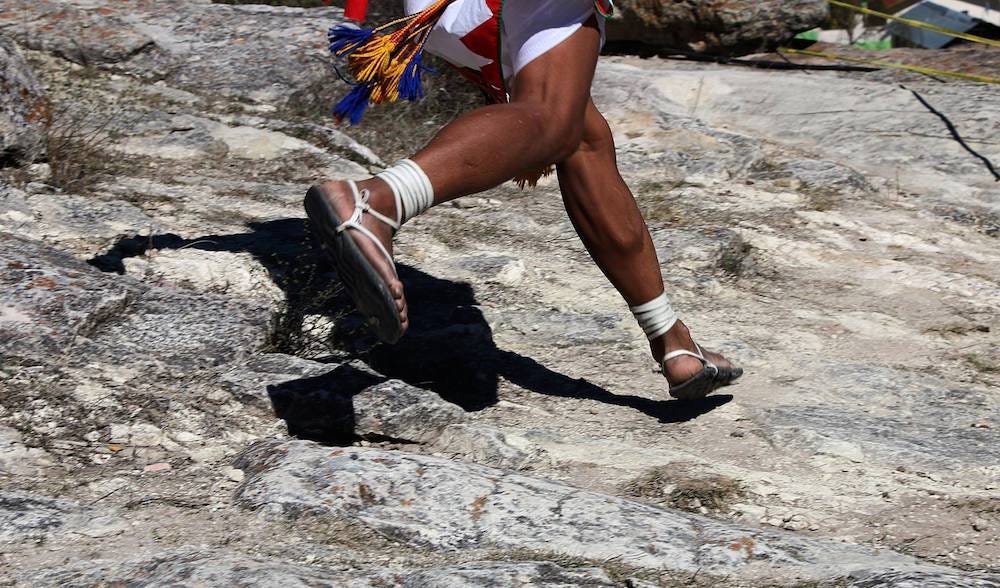Housekeeping
Full access to this post and it’s audio version is for Members of 2%. Become a Member below.
On Monday, we covered athletic shoes.
But I lied to you. I told you today’s post would cover various topics, including rucking shoes.
Then I began to write and the post got long. Too long. The section on rucking shoes took on a life of its own.
So that section—a guide to rucking shoes—will be in Monday’s newsletter.
This leaves us with two topics today:
The truth about minimalist shoes. (We’ll break down some of the good and bad of the trend).
The shoes I use for different workouts (e.g., road running, trail running, lifting, etc).
Let’s roll …
The truth about minimalist shoes
In short
Minimalist shoes are good for some people but aren’t better than standard running or athletic shoes. They may decrease performance in some populations.
The details
On Monday, we covered the reactionary roller coaster of trends in athletic shoes.
Of all the trends over the last two decades, the minimalist shoe craze may have had the most impact.
In this section, we’ll dive into what minimalism got right and wrong and what we can learn from that.
The case for minimalist shoes
From the 1970s to 2000, most people ran in standard running shoes: supportive and with a drop of around 7 to 10mm. Drop, as a reminder, is the difference between the height of a shoe’s heel and its toe box.
But in the 2000s, popular new books and articles argued that the high injury rates of running were due entirely to these standard running shoes.
When runners wear shoes with support and drop, they tend to first hit the ground with their heel (heel striking). This, minimal-shoe enthusiasts argued, was leading people to get injured. (We covered this a bit on Monday, but this is a reminder as we go deeper …)
The minimalist camp pointed at how our early ancestors likely ran great distances barefoot or in thin leather moccasins or sandals. I.e. Zero drop and unsupported.
When people run barefoot or in minimalist footwear, they tend to strike the ground with their midfoot or forefoot first.
So the argument was basically this:
Humans have a long history of running barefoot or in minimalist shoes—and, in turn, midfoot or forefoot striking.
Running this way is the correct, natural, and less risky way for humans to run.
Meanwhile, running in supportive shoes and heel-striking is the opposite: incorrect*, unnatural, and more risky.
The rise of the tribal runners
Proponents of minimalist shoes pointed to tribes like the Rarámuri (also known as the Tarahumara) of Mexico. Some Rarámuri ran ultra-distance races at professional paces wearing only basic sandals. Minimalist shoe enthusiasts believed the Rarámuri didn’t get injured.
The thinking was that their zero-drop, “minimalist” or “barefoot” shoes and lack of heel-strike running were a huge factor in their endurance and durability.
So if we all switched to minimalist shoes, the thinking went, we’d all run like the Rarámuri—better with fewer injuries.
Where minimalism went wrong
We now know it’s not that simple.
Or else we’d all be running in minimalist shoes, and running injury rates would have plummeted. But they haven’t changed since the 1970s.
We’ve since learned that there isn’t much difference in injury rates between runners who use more supportive shoes with drop and those who use minimalist, zero-drop shoes.
And much of the information about the runner tribes lacked context and perhaps didn’t apply to the average American runner.
For example:
Many tribe members lived, worked, and ran in those flat sandals their entire lives.
When the tribe members ran, it was often on softer ground, not pavement.
The Rarámuri weighed significantly less than the average American. Their average weight is 110 pounds, and their BMI is around 20. Ours is around 175 pounds with a BMI of 27. (Body weight factors into running injuries).
The tribes weren’t sitting at a desk for eight hours a day like we often do, which is known to change movement patterns. That could also influence injury.
Some of the information was wrong.
Mainly, the tribe members do get injured.
Anthropologists at Harvard who lived with the Rarámuri runners report that they all have aches and pains after their long runs.
The upsides of the minimalist craze
There are a lot of factors that go into running performance and injury rates. Shoes are just a slice of the pie.
The minimalist craze got us thinking more about footwear and running form. I don’t think it was a bad thing.
I’d bet many readers of 2% tried minimalist shoes during the craze and loved them—and still run in them. I’ll occasionally break out a pair of minimalist shoes for a short trail run. Trends allow us to try a new idea and see if it works for us.
But that doesn’t mean it’s “wrong,” “unnatural,” or “riskier” to run in more supportive shoes—or that running in minimalist shoes is inherently better.
If anything, minimalist shoes decrease performance at the highest levels. Remember: Most professional runners use standard running shoes.
A good rule of thumb: Work what works for you—and be sure it works.
Which brings me to what works for me …
The shoes I use
In short
See the list below!
The details
Here are the shoes I use now. Please weigh in with your own favorites in the comments. Let’s hive mind this.





